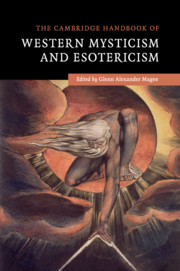Book contents
- Frontmatter
- Dedication
- Contents
- Acknowledgments
- Editor's Introduction
- List of contributors
- I ANTIQUITY
- II THE MIDDLE AGES
- III THE RENAISSANCE AND EARLY MODERNITY
- IV THE NINETEENTH CENTURY AND BEYOND
- 20 Spiritualism
- 21 H. P. Blavatsky and Theosophy
- 22 Rudolf Steiner and Anthroposophy
- 23 The Golden Dawn and the O.T.O.
- 24 G. I. Gurdjieff and the Fourth Way
- 25 C. G. Jung and Jungianism
- 26 René Guénon and Traditionalism
- 27 Via Negativa in the Twentieth Century
- 28 Contemporary Paganism
- 29 The New Age
- V COMMON THREADS
- Suggestions for Further Reading
- Index
- References
28 - Contemporary Paganism
from IV - THE NINETEENTH CENTURY AND BEYOND
Published online by Cambridge University Press: 05 May 2016
- Frontmatter
- Dedication
- Contents
- Acknowledgments
- Editor's Introduction
- List of contributors
- I ANTIQUITY
- II THE MIDDLE AGES
- III THE RENAISSANCE AND EARLY MODERNITY
- IV THE NINETEENTH CENTURY AND BEYOND
- 20 Spiritualism
- 21 H. P. Blavatsky and Theosophy
- 22 Rudolf Steiner and Anthroposophy
- 23 The Golden Dawn and the O.T.O.
- 24 G. I. Gurdjieff and the Fourth Way
- 25 C. G. Jung and Jungianism
- 26 René Guénon and Traditionalism
- 27 Via Negativa in the Twentieth Century
- 28 Contemporary Paganism
- 29 The New Age
- V COMMON THREADS
- Suggestions for Further Reading
- Index
- References
Summary
Introduction
With few exceptions, such as Feraferia and the Church of All Worlds in the United States (both products of the 1960s), today's Pagan religions present themselves as reviving, reconstructing, or somehow connecting with a pre-Christian past. For example, the founders of modern Wicca initially claimed an unbroken continuity with the Stone Age via a persecuted, underground religious tradition that persisted in England until the 1930s – a claim that owed much to the theories of the English archaeologist Margaret Murray. Other contemporary Pagan leaders and theorists have claimed that earlier forms of their religions can be recovered from fragments of folklore, folk dance, ancient artwork, and mythic tales. Homo religiosus prizes that which is ancient, but the actual development of contemporary Paganism primarily occurred in the late nineteenth and twentieth centuries, involving the work of many creative men and women, some of whom merely expressed their own spiritual longings while others sought consciously to create a communal movement – a religion. But before examining this history, let us consider how “Pagan” is defined today.
Defining Paganism
Pagan religions, while varied in their expression, offer certain common expressions and family resemblances. These include a view of deity as multiple rather than single; a view of nonhuman nature as valuable in and for itself, and not created merely for our use; and a tendency to focus on time as cyclical, rather than as moving toward an apocalypse, last judgment, or final goal. Thus, from the contemporary Pagan's viewpoint, such varied traditions as classical Roman religion, shrine Shinto, Wicca, aspects of Hinduism, and indeed any “indigenous” religion might all be seen as Pagan. Attempting to reduce these multiplicities to their simplest terms, Michael York in Pagan Theology offers this broad definition: “an affirmation of interactive and polymorphic sacred relationship by the individual or community with the tangible, sentient, and/or nonempirical.”
In other words, for the Pagan, “sacred relationships” may be with tangible objects that evoke holiness, awe, or humility. These might be natural objects or persons – a mountain, a canyon, a tree, an animal – or they may be manmade. They may include other humans, when those persons manifest a deity or a deity's attributes. Pagans may also, of course, enjoy a relationship with “the sacred” expressed in nonempirical form – through contemplation, dreams, visions, and so on.
- Type
- Chapter
- Information
- The Cambridge Handbook of Western Mysticism and Esotericism , pp. 334 - 343Publisher: Cambridge University PressPrint publication year: 2016

